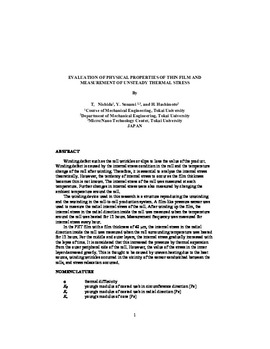| dc.contributor.author | Nishida, Takeshi | |
| dc.contributor.author | Sunami, Yuta | |
| dc.contributor.author | Hashimoto, Hiromu | |
| dc.contributor.other | International Conference on Web Handling (2019) | |
| dc.date.accessioned | 2019-06-04T16:16:33Z | |
| dc.date.available | 2019-06-04T16:16:33Z | |
| dc.date.issued | 2019-06 | |
| dc.identifier | oksd_icwh_2019_nishida | |
| dc.identifier.citation | Nishida, T., Sunami, Y., & Hashimoto, H. (2019, June). Evaluation of physical properties of thin film and measurement of unsteady thermal stress. Paper presented at the Fifteenth International Conference on Web Handling (IWEB), Stillwater, OK. | |
| dc.identifier.uri | https://hdl.handle.net/11244/320253 | |
| dc.description.abstract | Winding defect such as the roll wrinkles or slips to lose the value of the product. Winding defect is caused by the internal stress condition in the roll and the temperature change of the roll after winding. Therefore, it is essential to analyze the internal stress theoretically. However, the tendency of internal stress to occur as the film thickness becomes thin is not known. The internal stress of the roll was measured at each temperature. Further changes in internal stress were also measured by changing the ambient temperature around the roll. | |
| dc.description.abstract | The winding device used in this research is a structure reproducing the unwinding and the rewinding in the roll-to-roll production system. A film-like pressure sensor was used to measure the radial internal stress of the roll. After winding up the film, the internal stress in the radial direction inside the roll was measured when the temperature around the roll was heated for 12 hours. Measurement frequency was measured for internal stress every hour. | |
| dc.description.abstract | In the PET film with a film thickness of 40 μm, the internal stress in the radial direction inside the roll was measured when the roll surrounding temperature was heated for 12 hours. For the middle and outer layers, the internal stress gradually increased with the lapse of time. It is considered that this increased the pressure by thermal expansion from the outer peripheral side of the roll. However, the value of the stress in the inner layer decreased greatly. This is thought to be caused by uneven heating due to the heat source, winding wrinkles occurred in the vicinity of the sensor sandwiched between the rolls, and stress relaxation occurred. | |
| dc.format | application/pdf | |
| dc.language | en_US | |
| dc.publisher | Oklahoma State University | |
| dc.rights | In the Oklahoma State University Library's institutional repository this paper is made available through the open access principles and the terms of agreement/consent between the author(s) and the publisher. The permission policy on the use, reproduction or distribution of the article falls under fair use for educational, scholarship, and research purposes. Contact Digital Resources and Discovery Services at lib-dls@okstate.edu or 405-744-9161 for further information. | |
| dc.title | Evaluation of physical properties of thin film and measurement of unsteady thermal stress | |
| osu.filename | oksd_icwh_2019_nishida.pdf | |
| dc.type.genre | Conference proceedings | |
| dc.type.material | Text | |
